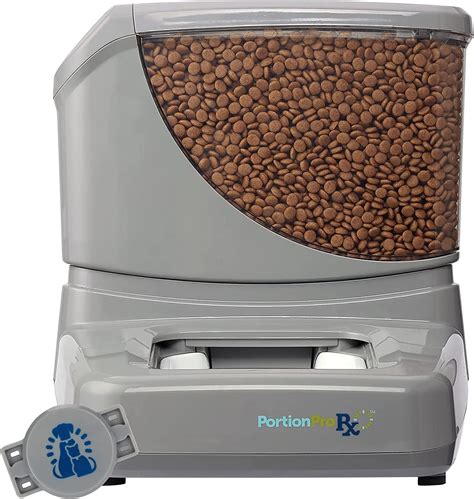Introduction: Unleash the Power of Advanced Pet Care
In the ever-evolving realm of pet ownership, technology has emerged as a game-changer, empowering us with innovative solutions to enhance the well-being of our furry companions. Among these cutting-edge advancements, the RFID Pet Feeder stands as a shining example of how technology can transform the way we care for our beloved animals.

RFID, an acronym for Radio Frequency Identification, utilizes radio waves to transmit data, making it an ideal technology for pet feeding systems. RFID Pet Feeders utilize this technology to identify individual pets and track their feeding habits, revolutionizing the way we manage their nutrition.
How RFID Pet Feeders Work
RFID Pet Feeders consist of a food bowl and an RFID reader. The food bowl is equipped with an RFID tag, while each pet is assigned a unique RFID collar tag. When a pet approaches the food bowl with its collar tag, the RFID reader detects the tag and identifies the pet.
The feeder then dispenses the appropriate amount of food based on the pet’s dietary requirements, which are programmed into the feeder’s memory. This automated process eliminates overfeeding, ensures that each pet receives its individualized nutrition, and provides pet owners with peace of mind.
Benefits of RFID Pet Feeders
RFID Pet Feeders offer a multitude of benefits to pet owners, making them an ideal solution for modern pet care. Here are some of the key advantages:
-
Personalized Nutrition: RFID Pet Feeders allow you to tailor the feeding plan for each pet based on their age, weight, activity level, and dietary restrictions.
-
Portion Control: The feeder accurately dispenses the correct amount of food, preventing overfeeding and promoting weight management.
-
Meal Time Tracking: RFID Pet Feeders track the feeding history of each pet, providing valuable insights into their eating habits and helping you identify any potential health issues.
-
Convenience: RFID Pet Feeders automate the feeding process, freeing up your time and ensuring that your pets are fed on time, even when you’re away from home.
-
Pet Safety: RFID Pet Feeders eliminate the risk of food theft by other animals, ensuring that your pets have access to their food at all times.
How to Train Your Pets with RFID Pet Feeder
Training your pets to use an RFID Pet Feeder is a simple and rewarding process. Here’s a step-by-step guide to get you started:
-
Introduce the Feeder: Place the RFID Pet Feeder in a quiet and easily accessible location for your pets. Allow them to explore the feeder and get comfortable with it.
-
Associate the Feeder with Food: Fill the food bowl with your pet’s favorite food. When your pet approaches the feeder, place their collar tag near the RFID reader. The feeder will dispense food, associating the feeder with a positive experience.
-
Repeat the Process: Repeat steps 1 and 2 until your pet consistently approaches the feeder with their collar tag.
-
Reward Good Behavior: Praise and reward your pet for using the RFID Pet Feeder correctly. This positive reinforcement will reinforce the desired behavior.
Comparison of RFID Pet Feeders vs. Traditional Pet Feeders
Traditional pet feeders lack the advanced features and benefits of RFID Pet Feeders. Here’s a comparison of the two types of feeders:
| Feature | RFID Pet Feeder | Traditional Pet Feeder |
|---|---|---|
| Pet Identification | Utilizes RFID tags to identify individual pets | No pet identification |
| Portion Control | Dispenses accurate portions based on pet’s dietary requirements | No portion control |
| Meal Time Tracking | Tracks feeding history for each pet | No meal time tracking |
| Convenience | Automates feeding process | Manual feeding |
| Pet Safety | Prevents food theft by other animals | No protection against food theft |
Common Mistakes to Avoid
To ensure successful training and effective use of RFID Pet Feeders, it’s important to avoid certain common mistakes:
-
Improper Placement: Placing the feeder in a high-traffic area or near other animals’ food bowls can confuse your pets and make training more difficult.
-
Inconsistent Training: Training should be consistent to help your pets understand the desired behavior. Avoid using multiple feeders or varying the training process.
-
Overfeeding: While RFID Pet Feeders make portion control easier, it’s essential to monitor your pets’ weight and adjust the feeding settings accordingly to prevent overfeeding.
-
Ignoring Meal Time Tracking: Regularly reviewing the feeding history can provide valuable insights into your pets’ eating habits and help you identify any potential health issues.
Case Study: RFID Pet Feeder Success Stories
Numerous pet owners have experienced the transformative power of RFID Pet Feeders. Here are some real-life success stories:
-
Case 1: A multi-pet household with dogs and cats struggled with overfeeding and mealtime aggression. An RFID Pet Feeder resolved these issues by providing personalized nutrition and eliminating competition for food.
-
Case 2: A pet owner with a newly adopted dog with an unknown history found the RFID Pet Feeder invaluable in tracking the dog’s eating habits and ensuring its nutritional needs were met.
-
Case 3: A pet owner traveling frequently for work found the RFID Pet Feeder to be an ideal solution, providing peace of mind knowing that their pets were being fed on time, even in their absence.
Conclusion: Revolutionizing Pet Care with RFID Pet Feeders
RFID Pet Feeders represent a leap forward in pet care technology. Their advanced features and benefits empower pet owners to provide personalized nutrition, prevent overfeeding, track meal times, and ensure the overall well-being of their beloved companions. By embracing this innovative technology, you can enhance the health, happiness, and convenience of your pets’ daily lives.





















